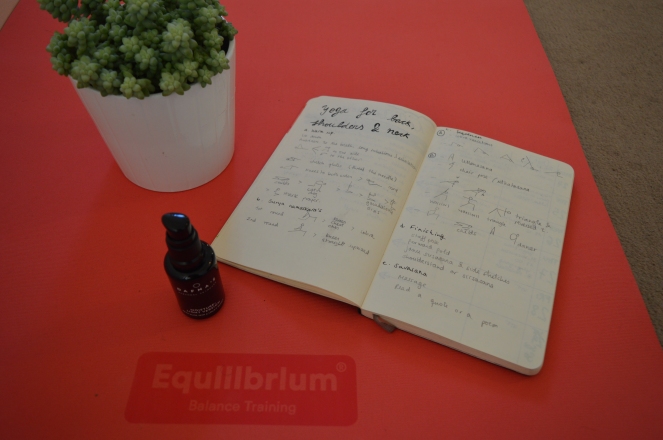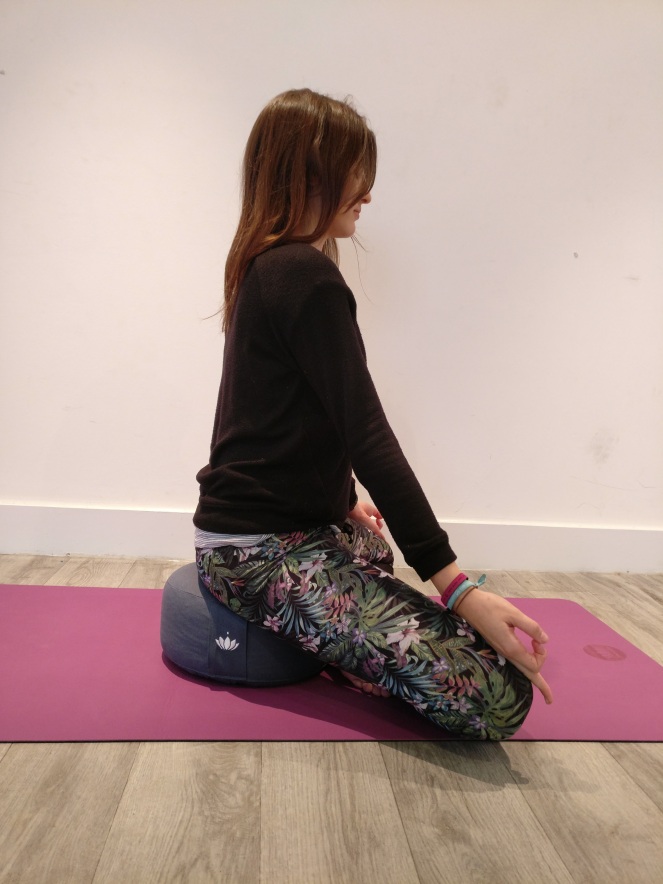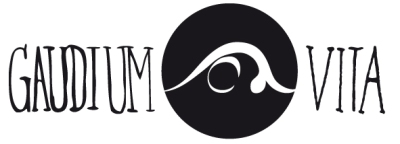Hace un par de semanas hice mi primera observación de una clase de yoga y quería contaros un poco más sobre esta experiencia. ¡Allá vamos!
Como parte de mi Yoga Teacher Training, tenemos que observar de 3 clases de vinyasa yoga, esto significa ir a la clase, sentarse en la parte de atrás con un cuaderno y escribirlo todo todito sobre la clase. Yo me lo he tomado muy en serio porque creo que es una excelente oportunidad para:
- Ver una clase de yoga desde una perspectiva diferente, ver la respuesta de los estudiantes (cosa que cuando somos estudiantes no podemos hacer)
- Hacer “networking” con algunos de mis profesores de yoga favoritos
- Aprender de esos profesores
- ¿Qué me gusta y quiero incorporar a mis clases?
- ¿Qué no me gusta y quiero evitar en mis clases?
- Inspiración: nuevas secuencias, flows, posturas, maneras de explicar, demostraciones, ajustes, props …
Primer paso: escoge tu profe y pídeselo con antelación
Si quieres hacer algo como esto o te han pedido que lo hagas en tu formación, ten en cuenta que tienes que preguntarles por adelantado, nunca ir a una clase y preguntarles “¿Puedo observar esta clase?”. Simplemente no es adecuado, especialmente si no te conocen muy bien. Además, preguntarles con antelación también es una buena manera de presentarse.
https://www.instagram.com/p/BLa9peQAQIs/?taken-by=mischavarmuza
Segundo paso: prepárate para la clase
Tendrás que asegurarte de que el estudio permite observaciones y tienes que ofrecerte a pagar por la clase, porque aunque no la hagas estás ocupando un espacio. Además, envíale un recordatorio a el profesor cerca de la fecha, que probablemente tiene muchas cosas en la cabeza, así que no des por sentado que se va a acordar de la observación.
Prepara un cuaderno y un par de bolis. ¿Te imaginas estar sentado allí y darte cuenta de que no tienes un bolígrafo o que te estás quedando sin tinta? ¡Qué pesadilla! Le pasó a uno de mis colegas y tomé nota de llevarme más de un boli conmigo;)

Tercer paso: la observación
- Cuando llegues al estudio, vuelve a presentarte y pregunta al profesor dónde quiere que te sientes. Yo me senté en la parte de atrás de la clase, en un lugar donde tenía una buena perspectiva, pero no molestaba a nadie.
- Siéntate cómodo (yo usé un bolster), pero ten cuidado con la forma como te sientas: siéntate como un yogui. Así darás una buena impresión y pasarás más desapercibido.

- Se discreto, especialmente en Savasana. La gente se dará cuenta de que estás ahí, pero tienes que hacer todo lo posible para no molestar a la gente que está intentando practicar.
- Ten cuidado al mirar a la gente. ¡Esto es muy difícil y muy importante! Tienes que mirar a los estudiantes, ver cómo responden a las instrucciones y el nivel de la clase, pero … ¡NO LOS MIRES DIRECTAMENTE! Es extraño e incómodo. Lo que yo hice fue escribir notas cuando los estudiantes podían verme y luego observarlos cuando sabía que no podían verme.
- ¡Toma tantas notas como creas! ¡Y disfruta de tu observación! Definitivamente disfruté mucho de la mía aunque a ratos estaba pensando “Vaya pasada, me gustaría estar haciendo la clase”, pero valió la pena.

Cuarto paso: crea tu propio guión de la clase
Yo escribí alrededor de 4 o 5 páginas de mi diario, y luego, cuando llegué a casa, lo pasé a limpio para que me fuera más útil. ¿Qué escribí? Aquí tienes una lista:
- Información general: estudio, profesor, número de estudiantes, duración, nivel, estilo …
- Secuencia de la clase y tiempo
- Práctica: bienvenida, calentamiento, saludos al sol, posturas de pie, …
- Descripción o diagrama
- Método (¿cómo fue enseñado, demostraciones?)
- Consejos de enseñanza, elogios, comentarios
- Accesorios y modificaciones
- Precauciones
- Visión general
- ¿Cuál fue la naturaleza de la experiencia de los estudiantes?
- ¿Cómo fue la estructura, el flow y la estructura?
- ¿Qué es lo que menos me gustó de la clase?
- ¿Qué es lo que más me gustó?
- ¿Qué usaría en mi propia enseñanza?
- ¿Qué no usaría?
Por la próxima vez: Necesito escribir un poco más, necesito enfocarme más en lo que el maestro dice en lugar de enfocarme tanto en la secuencia de asanas. Mañana voy otra vez a TripYoga para mi observación con Mischa, ya os contaré como va.
Recomiendo esta experiencia a todos los esos yoguis apasionados, especialmente a aquellos que quieren hacer una formación o que ya la estan haciendo (incluso si su curso no requiere hacerlo). Vale la pena. Aprendí mucho …
Nos leemos pronto,
Namaste
Ariadna 🙂
[EN]
A couple of weeks ago I did my first yoga class observation and I wanted to tell you a little bit more about this experience. So, there we go!
As part of my Yoga Teacher Training, we are meant to do 3 vinyasa yoga class observations, this means going to a yoga class, sitting at the back with a notebook and writing everything about the class. I took this very seriously because I thought it was an excellent opportunity to:
- See a yoga class from a different perspective, see the students response
- Get in touch with some of my favourite and most inspiring yoga teachers
- Learn from the teachers:
- What do I like and want to incorporate into my classes?
- What do I dislike and want to avoid in my classes?
- Get inspiration: new sequences, flows, postures, quotes, queues, demonstrations, adjustments, props…
First step: choose your yoga teacher and ask them in advance
Luckily for the first two observations I didn’t have to think too much. I knew that I wanted to observe a class with Paula Andreewitch and another one with Mischa Varmuza. So, although I was a bit nervous about this, I went and asked Mischa at the end of one of her classes and she said it was OK. With Paula I sent her an email and she was also happy with it.
If you want to do something like this or you have been asked to by your Teacher Training course, keep in mind that you need to ask them in advance, never show up to a class and ask them “can I observe this class?”, it’s just not polite, specially if they don’t know you very well. It is also a good way to introduce yourself.
https://www.instagram.com/p/BLa9peQAQIs/?taken-by=mischavarmuza
Second step: Get ready for the class
You’ll need to make sure the studio allows observations and your need to offer yourself to pay for the class. Also, send a reminder to the teacher close to the date, they probably have many things in mind so don’t take for granted that they will remember about the observation. Prepare a notebook, and a couple of pens. Can you imagine sitting there and realising that you don’t have a pen or that you are running out of ink? What a nightmare! It happened to one of my colleagues and I took his advice of taking more than one pen with me 😉

Third step: Observation
- When you arrive to the studio, introduce yourself again and ask the teacher where does he/she want you to sit.I sat at the back of the class, in a place where I had a good perspective but wasn’t annoying anyone.
- Make yourself comfortable (I used a bolster) but be careful of the way you present yourself: sit like a yogi.

- Be discreet, specially in Savasana. People will notice you but you have to make every effort to be quiet and allow the class to flow.
- Be careful about staring at people. This is very difficult and very important! You have to look the students, see how they respond to the instructions and the level of the class but… DON’T STARE AT THEM! It is just weird and uncomfortable. What I did was write notes when the students could see me and then observe them when I knew they couldn’t see me.
- Take as many notes as you need! And enjoy your observation! I definitely enjoyed mine a lot although I was thinking all the time “This is so good, I wish I was doing the class” but it was worth it.

Fourth step: Create a transcript of the observation
I wrote about 4 or 5 pages of my journal, and then when I got home I put everything together in a word:
- General information: studio, teacher, number of students, length, level, style…
- Class sequence and timing
- Practice: welcome, centring, warm up, sun salutations, standing, seated…
- Description or diagram
- Method (how was it taught, demonstrations?)
- Teaching tips, praise, comments
- Props and modifications
- Precautions
- General overview
- What was the nature of the students’ experience?
- How was the structure, flow and timing?
- What did I like the least about the class?
- What did I like the most?
- What would I use in my own teaching?
- What wouldn’t I use?
For the next time: I need to write a bit more, I need to focus more on what the teacher says rather than focusing on the asana flow. I am going tomorrow for my observation with Mischa, I’ll let you know how it goes.
I recommend this experience to all passionate yogis, especially to those who want to do a teacher training or are doing one (even if your course doesn’t require you do it). It is worth it. I learnt a lot…Already looking forward to the observation tomorrow 🙂
“See” you soon,
Namaste
Ariadna 🙂

Me ha encantado y me viene genial para cuando empiece mi formación en unas cuantas semanas 🙂 gracias Ari!
M'agradaM'agrada
Ya te has decidido? Dónde la harás? Un saludo!!
M'agradaM'agrada
Genial post!!!!!! Encara que no ho he fet mai trobo que gaudir d’una classe com observant t’ha de donar molts bons fruits!!!
M'agradaM'agrada